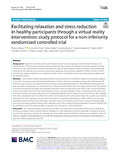Citation link:
http://dx.doi.org/10.25819/ubsi/10243Files in This Item:
| File | Description | Size | Format | |
|---|---|---|---|---|
| Facilitating_relaxation_and_stress_reduction.pdf | 1.11 MB | Adobe PDF |  View/Open |
| Dokument Type: | Article | metadata.dc.title: | Facilitating relaxation and stress reduction in healthy participants through a virtual reality intervention: study protocol for a non-inferiority randomized controlled trial | Authors: | Kampa, Miriam Bucher, Leandra Klapperich, Holger Mertl, Fabian Zimmer, Christian Geiger, Christian Hassenzahl, Marc Finke, Johannes Stalder, Tobias Klucken, Tim |
Institute: | Fakultät V - Lebenswissenschaftliche Fakultät | Free keywords: | Virtual reality, Relaxation, Stress reduction, Stress test, Randomized controlled trial | Dewey Decimal Classification: | 150 Psychologie | GHBS-Clases: | HQN HQR HUF HWYM |
Issue Date: | 2022 | Publish Date: | 2022 | Source: | Trials ; 23, article number 380. - https://doi.org/10.1186/s13063-022-06307-8 | Abstract: | Background Repeated or chronic stress is considered a major source of disease, in terms of both somatic and mental illnesses. The prevention of stress-related disease by interventions for relaxation has thus increased societal relevance. In this randomized controlled non-inferiority trial, we will compare a newly developed virtual reality (VR) environment for relaxation to an active control group applying a freely chosen relaxation method. To test if our VR environment supports relaxation in a situation of acute stress, a standardized stress induction protocol will precede the relaxation phase. Methods One hundred healthy participants will be recruited from the University of Siegen and randomly assigned to the VR or the active control group that will be free to choose their own relaxation strategy. The multi-sensory VR includes visual, acoustic, and haptic features to induce a strong feeling of presence. The laboratory testing will comprise a baseline measurement, a stress induction, a relaxation intervention, and a recovery measurement. The primary outcomes are self-reported stress and relaxation measured with a visual analog scale (VAS) at pre- and post-baseline, at the start, middle, and end of the stress induction, at pre- and post-relaxation, at pre- and post-recovery, and in the evening of testing. Secondary outcomes are the physiological parameters, namely heart rate and heart rate variability, tonic skin conductance level as well as the number of non-specific skin conductance responses, systolic and diastolic blood pressure and respiratory rate recorded during the four experimental phases as well as state mood, and state rumination assessed at four time points (pre- and post-stress, post-relaxation, and in the evening of testing). Finally, post-event processing will be assessed after relaxation and in the evening of testing. Repeated measures ANOVAs will be performed to test for statistical effects of group, time, and group × time interaction. Discussion The newly developed, multi-sensory VR offers an intervention for relaxation without prior training. Its immersive character might increase efficacy compared to other relaxation methods, especially in situations of acute stress. Future directions could be the development of a mobile version of the VR to enhance accessibility for users. To achieve a transfer of training effects to real life, VR components should successively be eliminated until relaxation is practiced without guidance by the VR. |
Description: | Finanziert im Rahmen der DEAL-Verträge durch die Universitätsbibliothek Siegen |
DOI: | http://dx.doi.org/10.25819/ubsi/10243 | URN: | urn:nbn:de:hbz:467-24376 | URI: | https://dspace.ub.uni-siegen.de/handle/ubsi/2437 |
| Appears in Collections: | Geförderte Open-Access-Publikationen |
This item is protected by original copyright |
Page view(s)
360
checked on Dec 24, 2024
Download(s)
83
checked on Dec 24, 2024
Google ScholarTM
Check
Altmetric
Items in DSpace are protected by copyright, with all rights reserved, unless otherwise indicated.

